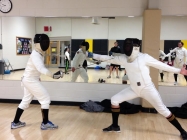

The fencing club lunges with dedication and precision
As one of the many student organizations at UMBC, the fencing club prides itself on practicing hard and welcoming newcomers.
Broken into three different weapon categories, sabre, épée and foil, the fencing club sure is dedicated to the art of the sport and, believe it or not, was actually one of the first sports-related clubs here at UMBC. Practices usually start off with warm-ups and footwork. Under their respective coaches, each squad does practice drills, different exercises and matches against each other.
Sidney Hahm, the current president and sophomore information systems major, said, “Our current coaches are alumni and have participated in this club as well when they were students, so it really has quite a history.” She has been fencing for over a year now and competes as much as she can.
Hahm admitted that even though some matches may look a bit aggressive and dangerous, fencing is actually one of the the safest Olympic sports. “The blades’ flexibility absorbs a lot of the force that you see in a match,” she added. Fencing is even safer than badminton, and is known for having one of the lowest injury rates in Olympic competitions.
The fencing club’s collegiate season isn’t over just yet. “Our épée squad is currently undefeated and in last year’s Baltimore Washington Collegiate Conference, the foil squad took first place, so we’re looking to keep up that trend,” said Hahm. They compete in one team-based meet during each semester, both leading up to a championship where they compete individually.
“Every year we hold a tournament fundraiser called Charm City in which very high rated fencers come to fence,” she said proudly. In return for organizing this fundraiser, the fencing club is granted the opportunity to participate in it for free.
As far as attire goes, each fencer is required to suit up in a form-fitting jacket with a strap which goes between the legs. Underneath the jacket, they wear an underarm protector for safety. They must also wear a mask with a bib to protect the neck and a glove covering their dominant hand.
Of course, it wouldn’t be fencing without the weapons. Sabre bladework targets everything except for the hands, and is the most fast paced of the three. Much slower and more calculated, épée bladework is the only one where the two fencers can actually score at the same time while targeting the entire body. Lastly, slower than sabre but faster than épée, foil bladework solely targets the torso.
Steven Milano, the vice president and a sophomore graphic design major, said, “Personally, fencing is an amazing outlet for me both physically and competitively. I currently have my E rating in foil.” The United States Fencing Association has established 6 different ratings. From the lowest to highest rating, there is U, E, D, C, B and A. Beginners are classified as “U” which stands for “Unrated.”
After running the track and stretching a bit, Milano leads everyone in a series of lunges within a straight line. These lunges function as either an advance towards a target for an attack or a backwards motion away from a target for protection. Following Milano, BJ Swayne, the head coach, then signals each squad to get together and practice challenging each other to a match.
“We usually gain the most popularity during the fall Involvement Fest,” said Hahm. The fencing club is pretty open when it comes to new members or anyone who just wants to attend a practice or two out of curiosity. Practices typically take place in the Fitness Studio from 8:30 p.m. to 10 p.m. every Tuesday and Thursday night.
Photo: Jamie Heathcote
Read more stories from: The Retriever Weekly





